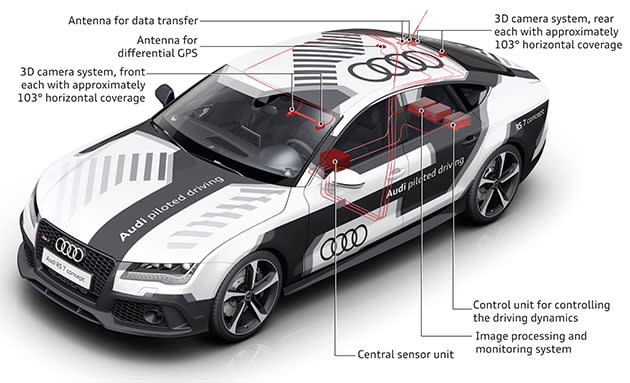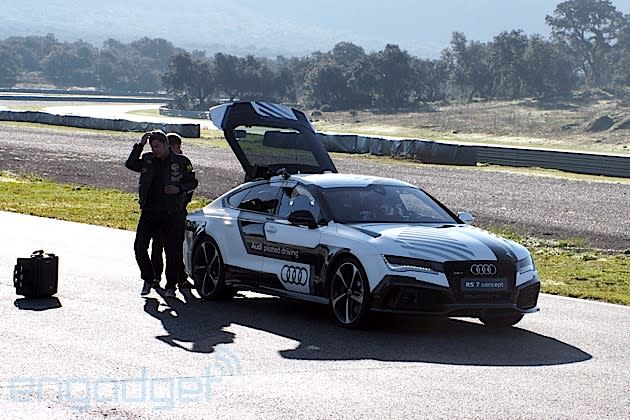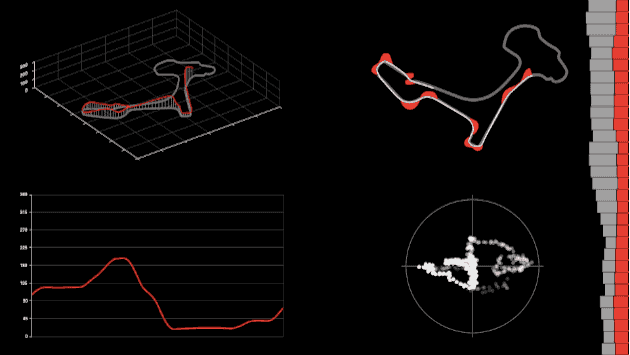Engadget has been testing and reviewing consumer tech since 2004. Our stories may include affiliate links; if you buy something through a link, we may earn a commission. Read more about how we evaluate products.
Riding in Audi's 150MPH self-driving RS 7, the anti-Google car

Until last week, the sum of my autonomous driving experience was sitting behind the wheel while a car parked itself, and the sum of my track experience involved squeezing my lanky frame into a comically small go-kart. Audi changed that recently, giving me the opportunity to sit in its self-driving RS 7 Concept while it traversed the Ascari racetrack in southern Spain. It's the same car that recently broke the autonomous speed record in Germany, hitting 240KPH (149MPH) at the Hockenheimring. Rather than aiming to improve on its record, Audi is at Ascari to test its "piloted driving" system against the circuit's more-challenging corners. It's also there to see how people react to being driven, at speed, around the track.
Created by the Dutch millionaire Klaas Zwart, Ascari is a "race resort" that gives the rich somewhere to safely push their vehicles to the limit. It also offers visitors a selection of exotic cars to test out. The circuit itself is vicious -- it was crafted to replicate the feel of various famous corners from around the racing world, and features climbs, chicanes, banked corners and other obstacles. To tackle Ascari at real pace is supremely difficult. So how exactly does this self-driving Audi do it?

Audi's setup uses GPS, but not the kind you'd find in a production car. Even if everything is working as intended, regular Audi in-car GPS systems are never more accurate than around a meter (just over three feet) -- that's great, but not much use on a track where a meter can be the difference between staying on the tarmac and smashing into a tire wall. Because of this, Audi has a second system in place that transmits corrected GPS signals over WiFi, bringing the tolerance down to an inch or so.
Anything that relies on communication with satellites floating 12,500 miles above the Earth is never going to be 100 percent foolproof, so in addition to the GPS equipment, Audi utilizes stereo cameras. These photograph the track continuously, relaying images to an onboard computer that compares them against photos from previous runs in real time. The computer looks out for environmental features to discern its location, improving accuracy and also acting as a fail-safe should the GPS flake out. Audi uses this location data in unison with a central sensor unit (a $50,000 box that you'd normally find in a race car) that feeds the computer information on lateral movement and g-forces along with other data.
While the tech here is different from Google's self-driving car, which uses radar and lasers in addition to cameras to find its way around, the basic idea is the same. First, you need a map -- in Audi's case the map is created by a human driving around the track. Then, you use sensors to compare where the vehicle is in real time against your data. The more accurate the data, and the fewer variables that are involved, the faster the vehicle can drive.
Nothing about the experience felt robotic.
So what's it actually like riding shotgun in an autonomous race car? Not too dissimilar to riding shotgun in a regular one. Upon arriving at Ascari, I had the opportunity to do a hot lap with one of Audi's drivers behind the wheel. On a wet track, he didn't exactly push the RS 7 to its limits, but the lap was still plenty fast enough for me. It's quite a "3D" track, with enough climbs and descents for me to at least worry about losing my stomach mid-lap, although thankfully my anxiety was unfounded.
Being chauffeured by both the car and a professional driver gave me the opportunity to compare the two driving styles. While the experienced driver constantly made adjustments to stay on the best line, Audi's piloted car tended to pick a single line around a corner and stick with it. The result is a slightly smoother drive from the piloted car, but not one that feels flaccid or over-controlled. For example, the computer allows the back end of the car to kick out when exiting corners, pushing its capabilities to the limit before wrestling back control.
Audi likes to say that its piloted cars (there are two, dubbed "AJ" and "Bobby") have unique characters, and nothing about the experience felt overly robotic -- aside from the steering wheel moving itself, of course. It's a lot of fun, if a little disconcerting, as evidenced by my gormless grins in the video below.
Everyone riding in the RS 7 Concept receives a "video postcard" of the experience.
Following the piloted experience, I jumped behind the wheel of a regular RS 7 for a lap of my own. Buoyed by the fact that other human drivers have bested the computer in the past, I had it in my mind I could outpace Audi's piloted RS 7. Although I've raced around Ascari many times in Gran Turismo 6, and so surely knew everything there was to know about driving, I was told to follow a pace car and mirror its movements to stick to a solid line. I did exactly as instructed, but it took just a few corners before I lost control of the back end of the car. Perhaps ironically, given my mission, I was only saved by the vehicle's ESP (Electronic Stability Program). With even the lowly pace car practically leaving me in the dust, I returned to the paddock, heart in mouth and egg on face, to discuss Audi's self-driving initiative with its head of development, Thomas Müller.
Google's bubble car doesn't fit into Audi's vision of the future.
Audi isn't looking to release a fully automated car anytime soon. Introducing the concept to me and other journalists, Müller not-so-subtly pokes fun at a "certain company's" efforts to build "robot taxis." It's clear Google's bubble car doesn't fit into Audi's vision of the future. "We don't want a car to be a device to carry you from A to B; we want you to love it, so we need to do things to make people love it."
Take control away from the driver, Müller says, and you take away the pleasure of driving. Instead, he wants piloted driving introduced in situations "where the customer doesn't have fun, where they're bored or stressed."
Müller points to previous Audi demonstrations for where the company is headed, noting that "in a traffic jam or on the highway, piloted driving is simple to manage." These are situations with very few variables for the car's computer to take into account. Put a self-driving car in a busy city and it'll have thousands of pedestrians and other potential hazards to monitor. This is obviously harder to safely achieve, and will also require the driver to be ready to take control back in an instant.
"With piloted driving, you need to manage every situation so the driver can sit there relaxed rather than monitoring things," Müller explains. Audi instead wants its drivers "to be like a pilot, who isn't sitting there looking out of the window all the time to see if another plane is coming, because the system is doing it for him." On a personal level, I agree with Müller's vision. I enjoy driving, and my brief time in the RS 7 showed me that -- so long as Audi can map the real world with as much precision as it can Ascari -- autonomous cars can take the wheel when I want them to, without forgoing the pleasure entirely.

Audi engineers make last-minute adjustments before a lap.
The race car, then, is simply Audi pushing its tech to its limits. Müller doesn't expect autonomous cars to deal with this sort of extreme challenge in real-world situations, but by developing a system to deal with 150MPH speeds, the company gains knowledge about real-time processing, and about its passengers. Emphasizing "assistive" over "autonomy" will, Audi hopes, help the tech pass regulatory hurdles. We've already seen lane assist, cruise control, automated parking and other tech make its way into production cars, and it's easy to see regulators approving (and customers embracing) a feature that takes over in traffic jams before they accept full autonomy.
It's easy to see regulators approving traffic jam assistance before they accept full autonomy.
Assessing how drivers will react to autonomous cars is a large part of why Audi is at Ascari in the first place. Design firm Kram/Weisshaar collaborated on the project, kitting out one of the self-driving cars with a high-tech feedback loop. First, a trio of screens mounted directly in front of the passenger seat displays data from the car's sensors. These are then mapped into fancy graphics (see below) that show position, trajectory and g-force data in real time, helping the passenger watch the car as it makes its way around the circuit. The visualizations were definitely helpful -- flying around a racetrack is extremely disorienting, and seeing how the car was reacting and plotting its route both enhanced my understanding of what was happening, and my enjoyment of it.
The second half of the feedback loop is focused on the passenger. The RS 7 is fitted with seven full-frame cameras and three microphones, which record reactions to the experience and the track. The purpose of this system is to give Audi a wealth of data on how regular humans (i.e., me and others invited to Ascari) react to being driven around by an autonomous race car. While Audi and Kram/Weisshaar will examine the data for months to come, there's a more immediate benefit to the camera setup: It's also used to provide participants with a personalized video hours after the drive to share on social media. This acts as a kind of "video postcard," helping my friends to see how stupid I look in an autonomous car, and Audi to get some free promotion for its research.

The above data is displayed in real time on dashboard-mounted displays.
Although it's a little early to draw any firm conclusions from the data, Reed Kram, co-founder of the eponymous design firm, tells me that initial reactions to the experience have been "euphoric." While I was perhaps a little more skeptical and a little less excitable than most that tried the RS 7 Concept, euphoria isn't a bad term to describe my mood immediately after the lap.
The Ascari demonstration is just the first in what Kram calls "an iterative process of research and development, prototyping and testing." The intention is to let even more people experience the technology in action, and Kram/Weisshaar's setup will help Audi to develop its robotic systems while gaining a greater understanding of how its customers will react to piloted driving.
"With robotic drivers and humans behind the wheel, the man-machine interfaces become critical."
Perhaps unsurprisingly, Kram shares Audi's vision that fully autonomous cars are not going to take over our roads anytime soon. "The reality will be much more gradual, with more and more driver assistance systems added to the mix," he says. Many assistive systems are already a reality, Kram explains, and over the next few years the challenge is to join the dots between them to create a singular experience. "In a world with robotic drivers and humans behind the wheel, the man-machine interfaces become critical."
Joining the dots isn't a purely technical challenge. While the work of engineers at Audi and other car companies is, of course, invaluable, design plays a key part in the experience of driving. "Too often people only imagine the entirely practical aspects," Kram says, "but ever-more autonomous cars can and should lead to new types of pleasure ... autonomous vehicles can be a hell of a lot of fun, and not electric wheelchairs, like other proposals."

The RS 7 Concept's trunk is full of electronics that process the video from Kram/Weisshaar's recording equipment.
The current experience of sitting in the driver's seat of a car is similar to being cocooned by instruments and controls. I'm curious as to how we might change the interior of a car, as we hand control of our vehicles over to computers for hours at a time. Surely they'll need to adapt to this change? Why not rethink the entire layout? Kram notes that interiors will become "an enclosed space for both heightened experience and speed at one end of the spectrum and contemplation and consideration at the other," but as the man in charge of making piloted driving a reality, Müller doesn't see the need to drastically change the cabin layout. He agrees that the current "cocoon" layout may not be ideal for piloted driving, but explains that if Audi were to, for example, allow the driver's seat to turn backward, it would take too long in an emergency situation to regain control.
My dreams of sipping whisky on the freeway will probably go unfulfilled.
My dreams of creating a social environment for drivers to relax and communicate with other passengers will probably go unfulfilled, but while I might never get the chance to sip whisky and play poker with friends on the freeway, Müller does have some practical examples of how future cars could improve the experience for drivers-turned-passengers. He floats the idea of an "electrical steering column that [as you enter piloted-driving mode] pulls the steering wheel back so you have more space in the cabin."
Müller also believes we could use some of the technology already in modern cars to take advantage of the freedom of autonomous vehicles. Current high-end Audis, he tells me, have some 13 motors already fitted inside the seats. These could be used to change the profile of a driver's seat when in piloted mode to make them more relaxed. Another idea, taking a cue from the heads-up displays already in cars, imagines having a video call projected onto the windshield of a car. "People will of course buy a car for piloted driving," he explains, "but maybe more so they'll be buying this 'room' that they get when being driven."
"People will of course buy a car for piloted driving, but maybe more so they'll be buying this 'room' that they get when being driven."
While other companies believe the future of driving should be a taxi-like experience, Audi wants being driven by an autopilot to feel more like taking a flight. My autonomous driving experience may have felt more akin to a fighter jet than a luxury airliner, but it's hard to not buy into Müller's piloted-driving vision. "You sit there and you have this TV and a nice seat and you're served; you're relaxed; you can look out of the window; it's like business class."
[Image credits: Aaron Souppouris (photos); Audi, Kram/Weisshaar (video, GIF)]
